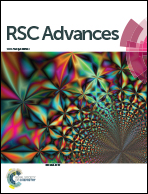A novel aptamer-mediated CuInS2 quantum dots@graphene oxide nanocomposites-based fluorescence “turn off–on” nanosensor for highly sensitive and selective detection of kanamycin†
Abstract
In this paper, we designed a novel near-infrared aptamer-mediated fluorescence “turn off–on” nanosensor for highly sensitive and selective detection of kanamycin based on CuInS2 quantum dots (QDs)@graphene oxide (GO) nanocomposites. The carboxy groups on the surface of CuInS2 QDs (modified with mercaptopropionic acid) were conjugated with amino terminal kanamycin-binding Ky2 aptamer to form the Ky2-CuInS2 QDs in the presence of 1-(3-dimethylaminopropyl)-3-ethylcarbodiimide hydrochloride and N-hydroxysuccinimide. Then, the Ky2-CuInS2 QDs were facilely immobilized on the surface of GO through π–π stacking interaction between the nucleobases and GO, which caused the fluorescence of Ky2-CuInS2 QDs “turned off”. In the presence of kanamycin, the Ky2-CuInS2 QDs desorb from the surface of GO and bind to kanamycin with high affinity and specificity. As a result, the quenched fluorescence “turned on”. Under the optimum conditions, there was a good linear relationship between I/I0 (I and I0 were the fluorescence intensity of Ky2-CuInS2 QDs@GO in the presence and absence of kanamycin, respectively) and kanamycin concentration in the range of 0.3–45 nmol L−1 (0.174–26.1 μg L−1), with the detection limit of 0.12 nmol L−1 (0.070 μg L−1). The present nanosensor was utilized to detect kanamycin in the human serum, urine and milk samples with satisfactory results.


 Please wait while we load your content...
Please wait while we load your content...